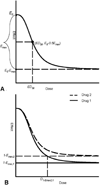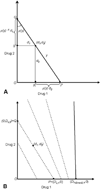Applying Emax model and bivariate thin plate splines to assess drug interactions
- PMID: 20036878
- PMCID: PMC4203317
- DOI: 10.2741/e90
Applying Emax model and bivariate thin plate splines to assess drug interactions
Abstract
We review the semiparametric approach previously proposed by Kong and Lee and extend it to a case in which the dose-effect curves follow the Emax model instead of the median effect equation. When the maximum effects for the investigated drugs are different, we provide a procedure to obtain the additive effect based on the Loewe additivity model. Then, we apply a bivariate thin plate spline approach to estimate the effect beyond additivity along with its 95 per cent point-wise confidence interval as well as its 95 per cent simultaneous confidence interval for any combination dose. Thus, synergy, additivity, and antagonism can be identified. The advantages of the method are that it provides an overall assessment of the combination effect on the entire two-dimensional dose space spanned by the experimental doses, and it enables us to identify complex patterns of drug interaction in combination studies. In addition, this approach is robust to outliers. To illustrate this procedure, we analyzed data from two case studies.
Figures






Similar articles
-
Emax model and interaction index for assessing drug interaction in combination studies.Front Biosci (Elite Ed). 2010 Jan 1;2(2):582-601. doi: 10.2741/e116. Front Biosci (Elite Ed). 2010. PMID: 20036904 Free PMC article.
-
Application and review of the separate ray model to investigate interaction effects.Front Biosci (Elite Ed). 2010 Jan 1;2(1):266-78. doi: 10.2741/e89. Front Biosci (Elite Ed). 2010. PMID: 20036877
-
Comparison of methods for evaluating drug-drug interaction.Front Biosci (Elite Ed). 2010 Jan 1;2(1):241-9. doi: 10.2741/e86. Front Biosci (Elite Ed). 2010. PMID: 20036874 Free PMC article.
-
A review of synergy concepts of nonlinear blending and dose-reduction profiles.Front Biosci (Schol Ed). 2010 Jan 1;2(2):483-503. doi: 10.2741/s80. Front Biosci (Schol Ed). 2010. PMID: 20036963 Review.
-
A mathematical approach to study combined effects of toxicants in vitro: evaluation of the Bliss independence criterion and the Loewe additivity model.Toxicol In Vitro. 2007 Aug;21(5):759-69. doi: 10.1016/j.tiv.2007.03.003. Epub 2007 Mar 12. Toxicol In Vitro. 2007. PMID: 17420112 Review.
Cited by
-
Emax model and interaction index for assessing drug interaction in combination studies.Front Biosci (Elite Ed). 2010 Jan 1;2(2):582-601. doi: 10.2741/e116. Front Biosci (Elite Ed). 2010. PMID: 20036904 Free PMC article.
-
Advances in Synergistic Combinations of Chinese Herbal Medicine for the Treatment of Cancer.Curr Cancer Drug Targets. 2016;16(4):346-56. doi: 10.2174/1568009616666151207105851. Curr Cancer Drug Targets. 2016. PMID: 26638885 Free PMC article. Review.
References
-
- Kanzawa Fumihiko, Nishio Kazuto, Fukuoka Kazuya, Sunami Toshihiko, Saijo Nagahiro. In vitro interactions of a new derivative of spicamycin, KRN5500, and other anticancer drugs using a three-dimensional model. Cancer Chemother Pharmacol. 1999;43:353–363. - PubMed
-
- Berenbaum Morris C. What is synergy? Pharmacol Rev. 1989;41:93–141. - PubMed
-
- Greco William R, Bravo Gregory, Parsons John C. The search of synergy: A critical review from a response surface perspective. Pharmacol Rev. 1995;47(2):331–385. - PubMed
-
- Chou Ting-Chao. Theoretical basis, experimental design, and computerized simulation of synergism and antagonism in drug combination studies. Pharmacol Rev. 2006;58:621–681. - PubMed
-
- Lee J Jack, Kong Maiying, Ayers Gregory D, Lotan Reuben. Interaction index and different methods for determining drug interaction in Combination Therapy. J Biopharm Stat. 2007;17:461–480. - PubMed
Publication types
MeSH terms
Substances
Grants and funding
LinkOut - more resources
Full Text Sources
Medical

